Cover Photo by Diane Nicole Photography

magazine A quarterly resource celebrating family life in Butte County since 2004 Winter Issue 2022 November - December - January









Nov 18, 2022 - Jan 8, 2023 turtlebay.org | 530-242-3123 presented by

Cover Photography by: Diane Nicole Photography (530) 588-4949 www.dianenicolephotography.com
Diane Nicole Photography is home to two brands: Wild Sage Portraits is Diane Nicole's family brand and all about capturing the fleeting moments. Her commercial brand, Social Lifestyle Photography, focuses on visuals for branding your business and headshots.


On The Cover: Avery and Vivienne Murray from Paradise
Advertising Deadline:






To advertise in our spring issue, please contact us by December 30th. Our spring issue will be on stands February, March, and April.
Contact Jason at: 530-591-2634 or jason@growingupchico.com
Growing Up Chico Magazine is published quarterly and available, free, at many family-friendly locations throughout Butte County. We are also available online at www.growingupchico.com.
Copyright © 2022 by Growing Up Chico Magazine. All rights reserved. Reproductions without permission are prohibited. Articles and advertisements found in Growing Up Chico Magazine do not necessarily reflect the opinions of the management or ownership. We reserve the right to edit. Every effort is made to avoid errors, misspellings, and omissions. If an error is found, please accept our sincere apologies and notify us of the mistake.
For Advertising Information, Contact Jason Corona: (530) 591-2634 jason@growingupchico.com

Aveed Khaki Publisher aveed@growingupchico.com (530) 519-5683























































































Kimberly Blaker

Kimberly is the mother of two grown children. She is an author and freelance writer and owns and operates an antiquarian bookstore.
Sandi Schwartz
Sandi is a freelance writer/blogger and mother of two. She has written extensively about parenting, wellness, and environmental issues. You can find her at www.happysciencemom. com.

Janeen Lewis
Janeen is a nationally published writer, teacher, and mom to Andrew and Gracie. Gardening with kids is one of her favorite pastimes.
Tanni Haas, Ph.D.


Tanni is a Professor in the Department of Communication Arts, Sciences, and Disorders at the City University of New York – Brooklyn College.































Find us! Like us! Follow us!







see what’s inside... Family Time 08 10 14 Why Family Dinners Matter: The Science of Eating Together Finding a Dog to Fit Your Family's Lifestyle Good Deeds to Better Your Community 10 22 26 Parenting How to Choose the Best Volunteer Activities for Your Family 10 Science-Backed Benefits of Practicing Gratitude with Kids Set the Stage for a Positive Dental Visit for Your Child 20 22 24 Winter Fun Connecting By Supporting The Importance of Shopping Local Things to Do on a Holiday Staycation 'Tis The Season to Go Plastic-Free 16 18 28 08 Winter Birthdays 10 Tips on Making Your Child's December Birthday Special 26

Why Family Dinners Matter: The Science of Eating Together WRITTEN BY TANNI HAAS, PH.D.
Most families find it difficult to get everyone together at the dinner table on a regular basis. We’re all so busy with after-school activities, late meetings at work, and long commutes. Decide to make a change this holiday season. Researchers have learned that eating dinner as a family is extremely important to kids’ physical, mental, and emotional health. As Dr. Anne Fishel, professor at Harvard Medical School and an expert on the benefits of family dinners, says: “Sitting down for a nightly meal is great for the brain, the body and the spirit.”
Healthier eating
Kids whose families have regular dinners together are often much healthier than those who don’t. They eat more fruits and vegetables, and consume less fried foods and soft drinks. They eat a wider variety of foods, and they continue to do so once they become adults. They’re also less likely to become obese. Researchers believe that’s because homemade meals are healthier than those in restaurants: we eat smaller portions, at a slower pace, and spend more time talking with one another.
Increased vocabulary
Dining with the family impacts kids’ minds as well as their bodies. Researchers have discovered that dinner-time conversations increase young kids’ vocabulary much more than being read to out loud. So, if you have a choice between coming home early for a family dinner or reading your kids a bedtime story, choose the dinner over the bedtime story. Kids who have a large vocabulary learn to read earlier and more easily than those with a more limited vocabulary. Researchers think that’s because kids constantly hear parents use new words during conversation.
Higher grades
These intellectual benefits carry over into academic achievement. Researchers have discovered that how well kids do in school is determined more by how often they participate in family dinners than by whether they do their homework consistently. Kids who dine regularly with their families are twice as likely to get A’s in school than those who rarely do.
Fewer risky behaviors
Having family dinners is also good for kids’ emotional health. When they dine

with their families, they’re much less likely to suffer from eating disorders, stress, depression, or abuse alcohol or drugs. Researchers believe that’s because parents who spend time with their kids at the dinner table are more in touch with their emotional well-being and can offer advice and support when needed. As a result, these kids also have higher selfesteem and trust others more.
Stronger family bonds
Finally, researchers have learned what we all probably know already: eating dinner together enhances family bonds. Kids whose families have regular dinners are much more likely to have good relationships with their parents and siblings. Kids say that talking, catching up, and just spending quality family time are much more important to them than what’s on the menu. Simply put, eating dinner together creates a strong sense of togetherness and feeling of belonging to a family. Dr. Fishel puts it well: “Dinner is a time to relax, recharge, laugh, tell stories and catch up on the day’s ups and downs, while developing a sense of who we are as a family.”
Happy Family Dinner!

8 growing up chico magazine www.growingupchico.com family time


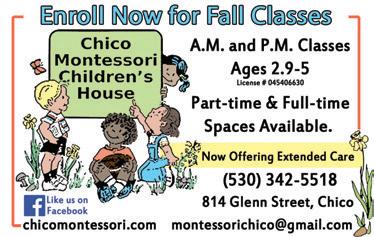

Every year thousands of dogs are turned over to animal shelters because they were given as a gift without first consulting the gift recipient—or families discover they brought home a biter, barker, digger, or jumper. When pets are given away, the pets, their owners, and children all suffer. So before selecting your dog, do your homework. With a little pre-planning, you can find the dog that most closely fits your family's or gift recipient’s lifestyle.
Variety of dogs, variety of nuisances Dogs can create many nuisances.
the house. Certain breeds tend to maintain that high energy level well into their adult-size bodies. Some of these high-energy breeds include Airedale Terriers, Boxer, Brittany, Cocker Spaniel, Dalmatian, Golden Retriever, Irish Setter, Jack Russell Terrier, Labrador Retriever, Pointer, and Schnauzer.
Dogs dig for many reasons—to bury a bone, to escape from a fenced yard, to keep cool, or out of boredom. A torn-up yard can be the last straw for many dog owners. The following breeds tend to be diggers: Fox Terriers, Norwich Terrier, and Petit Basset Griffon Vendeen.

Dogs can be aggressive for a variety of reasons. Poor breeding, physical abuse, and even disease can cause aggression in a dog. Certain dominant breeds can also tend toward aggressiveness if not handled by a firm and skilled handler. Choose these dogs with caution and the understanding they require strong leadership: Akita, American Pit Bull Terrier, Bulldog, Bullmastiff, Chow Chow, Doberman Pinscher, German Shepherd, Rottweiler, Schnauzer, Shih Tzu, Siberian Husky, and Weimaraner.
Grooming is another consideration. While it may sound painless, the upkeep of certain breeds can be overwhelming. In addition to keeping claws trimmed and an occasional bath, some dogs require lengthy daily brushing to remove tangles or trapped fur in double coats. High maintenance breeds include the American Eskimo, Cocker Spaniel, Collie, Great Pyrenees, Lhasa Apso, Old English Sheepdog, Poodle, Schnauzer, and Terriers.
Some of these are more common in particular breeds. A barking dog helps protect against intruders, but excessive barking can become a problem. Some breeds known for their barking include the Alaskan Malamute, American Water Spaniel, Bassett Hound, Finnish Spitz, Fox and other Terriers, Great Pyrenees, and Miniature Schnauzer.
A playful, energetic puppy can make a great playmate for your child. But as your puppy grows, that hyperactivity could become overwhelming. High-strung dogs often jump on people and tear through
Traits to look for in a family dog Many unforeseen problems are avoidable by finding a dog that'll be easy for your child to handle, so your child can assist in training. Easy trainers include American Water Spaniel, Australian Shepherd, Bichon Frise, Cocker Spaniel, Irish Setter, Italian Greyhound, Maltese, and Shetland Sheepdog.
Calm, gentle breeds are essential for families with small children. Keep in mind size alone doesn't dictate these traits. Gentle breeds you might consider are Bassett Hound, Beagle, Bearded Collie,

Finding a Dog to Fit Your Family's Lifestyle: Plan Ahead to Reap the Rewards of a Loving Family Pet
WRITTEN BY KIMBERLY BLAKER
10 growing up chico magazine www.growingupchico.com family time
Chinese Crested, Great Dane, Great Pyrenees, Newfoundland, and Mastiff.
Playful and energetic puppies work well for older children who won’t feel threatened by the dog’s full-grown size. Consider an American Eskimo, Bloodhound, Brittany, Dalmatian, Golden Retriever, Irish Wolfhound, Labrador Retriever, Pointer, Poodle, Saint Bernard, or Schnauzer.
There are many other traits to consider in choosing a new dog. Before bringing home your puppy, read a book or articles about the breed that interests you to determine if it will fit your family’s lifestyle. For assistance in choosing a breed, visit http://www.selectsmart.com/DOG/ or one of the many other breed selection sites. You’ll be guided through a series of questions and receive a free personalized list of matches.

Special considerations
The Centers for Disease Control and
Prevention estimate that 800,000 people, mostly children, are bitten severely enough annually to require medical attention. Infants and small children shouldn't be left alone with a dog. It may be hard to picture your lovable Fido as capable of hurting your child. But even the gentlest dogs have been known to bite.
Little kids sometimes get too close to a dog while it’s eating or chewing a bone or startle a dog while it’s sleeping. Sometimes, small children hang on dogs, pull their tails, or threaten a dog’s safety. This can lead to injury of either the dog or your child.
Also, dogs view their families as part of their pack. A properly trained dog should view adults and older children as alpha (top dog). But a dog isn't likely to see a small child in this light and may wield its authority when no one's around.
Apartment living is another consideration.
The size dog you choose is vital to both your dog's wellbeing and to maintain your sanity. High energy and mediumto-large breeds generally need large areas to romp. Without it, your apartment could become a round-the-clock racetrack. Planning regular walks for these dogs may not be sufficient. You'll tire long before your dog. Also, there will be occasions when you aren't able to accommodate your dog's need to exercise.
The costs of pet ownership should also be weighed out. First, there are obvious costs, such as pet food and annual vaccinations. Other expenses include licensing, monthly heartworm pills, chew toys, damaged belongings, fencing, training, unexpected veterinary expense, grooming, kenneling, and more.
If your family has members with bad allergies or asthma, check with your doctor before bringing any furred, feathered, or finned pet into your home.
Finally, keep in mind no matter how sincere your child's intent to care for his new pet, it's a big responsibility. Ultimately, parents take the brunt of the work. Also, the holiday season may not be the best time of year to bring home a new dog. Families are generally too busy during the holidays to give a new pet the attention it needs. Choose a season when you'll be able to spend plenty of time with your new dog as it adjusts to its new home.
Where to find your dog
The Butte Humane Society, SPCA, an animal shelter, or an accidental litter of pups is a great place to find your dog at an affordable price. Giving a home to a dog that might otherwise be put to sleep or caged indefinitely, and not contributing to the overpopulation of dogs by buying from breeders, are good reasons to go this route.
Most often, you'll find mixed breeds through these methods. Mixed breeds are less likely to inherit the diseases and disabilities often common in pure breeds. Keep in mind though, sometimes these dogs are strays or weren't properly cared for by their original owner. If a dog didn't receive proper vaccinations, it could be at risk for disease. A dog that was abused by its previous owner could also pose risks. Ask the animal shelter what it knows about the dog's history.
Another way to find your new puppy is through a breeder. Taking home a puppy whose history is known and hasn't been exposed to a poor environment is a plus. But caution should be used even when buying from a breeder. While most are in the business for their love of the breed, there are plenty of exceptions.
Some breeders are only interested in profits and have little knowledge or concern for good breeding and proper care of pups. This can lead to dogs with poor temperaments, genetic disorders, or disease. Ask plenty of questions, request references, and ask to see the puppies in their normal environment.
According to the American Kennel Club, some things to watch for when selecting your puppy include a runny nose, watery eyes, fever, or disease in the litter. If any of these conditions are present, it would
be a good idea to look elsewhere.
Avoid a puppy that trembles and is shy or one that shows a bad temper. Also, understand that a kennel designated "AKC Reg." doesn't mean it has the American Kennel Club's stamp of approval. It merely means the dogs are registered as being purebred.
Finally, keep in mind that puppies should remain with their mother until six weeks of age, and preferably 8.
Training Tips
No matter how careful you are in selecting your pet, chances are, your puppy will develop a problem or nuisance behavior. Prevention is the first step. Around six months, your puppy will be old enough for an obedience course. Teaching your puppy the basics will make it easier to manage problem behaviors. If you can't take a class, purchase a dogtraining manual and stick with it.
If your dog shows signs of aggression, talk with a professional trainer or your veterinarian. Depending on the cause, there may be a simple solution. But if your child's safety becomes an issue, your only option may be a new home for your pet.
Whether your dog ends up with a new owner or in a shelter, make sure you explain the reason for giving your dog away, so it ends up in the proper environment.
For other problem behaviors, there are several good books to help tame your dog. Decoding Your Dog: Explaining Common Dog Behaviors and How to Change or Prevent Unwanted Ones by the American College of Veterinary Behaviorists, provides many helpful techniques. Contrary to popular belief, never hit, kick, or swat a dog with a newspaper. This can lead to aggressiveness or increase already aggressive behavior.
Most importantly, try to understand and accept your pet's imperfections and adjust your home accordingly to reduce aggravations. In time, your dog will learn to accept the household routine and become a part of it.
Traveling with Puppy
For some families, going on vacation without their dog is like leaving a family member behind. Therefore, many hotels accommodate families who travel with pets. Try one of the following that offers pet-friendly services at some or most of its locations:
Residence Inn and TownePlace Suites by Marriott (800) 228-9290
Best Western (800) 528-1234

Hilton (800) 445-8667
Doubletree Hotels (800) 222-8733.
Embassy Suites (800) 362-2779
Holiday Inn (800) 465-4329
Comfort Inn (877) 424-6423
When Puppy Must Stay Behind
Traveling with your dog isn't always feasible. When looking for boarding services, ask the following questions, depending on your dog's needs.
Are kennels heated and cooled?
Are they indoor, outdoor, or accessible to both?
What kind of food do they provide?
Is one-on-one playtime or leashed walks offered?
What vaccinations are required?
12 growing up chico magazine www.growingupchico.com family time
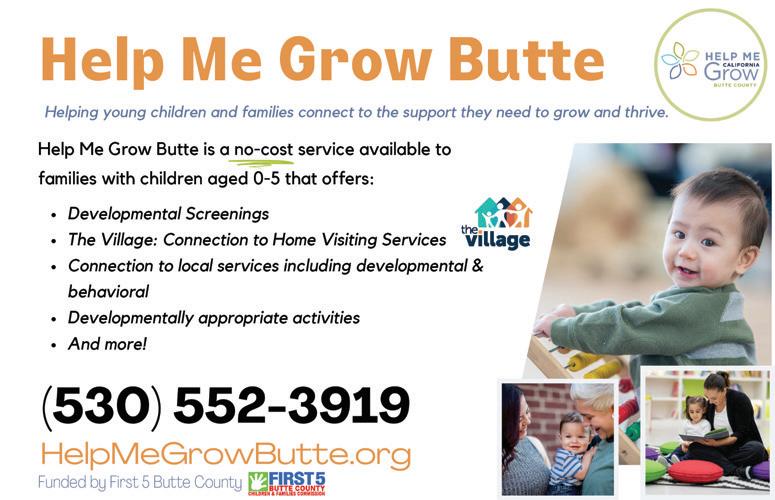



Good Deeds:
The holiday season is a great occasion to teach your kids the value of caring for the community, in which they live, especially those community members who can’t care as well for themselves. Here are 20 practical suggestions on what they can do:
1. Visit sick kids at the hospital. This is a wonderful gesture during the holidays or school breaks where everyone else is having fun.
2. Donate clothing and food to a homeless shelter. It will teach your kids the value of giving to those much less fortunate than themselves.
3. Help senior citizens learn to use technology, like how to search the
internet, send emails, and navigate their smartphones, so they can better communicate with family and friends.
4. Offer to paint a less well-maintained house in the neighborhood. There’s always that one house that could use some sprucing up.
5. Help coach a sports team with younger kids. This can be any sport they are good at or just like playing.
6. Assist senior citizens by helping them with their groceries or running errands around town.


7. Ask the library if they need tutors for younger kids in reading, writing, and basic math.
8. Volunteer for a clean-up day at a park. It’s needed in many places and a lot of fun to do, too.
9. Help out at charity shops. These shops rely on volunteers and can always use another helping hand.
10. Visit the residents at a nursing home or assisted living facility. Many residents get less visits from family and friends than most people realize.
11. Organize a back-to-school supplies drive for kids whose families have fallen on hard times.
12. Contact a school to see if they need a homework tutor for its after-school program. Sometimes, kids can explain things to other kids in a way that’s more relatable and makes more sense than adults.
13. Help care for the animals at the animal shelter. There’s nothing like giving a little love to an abandoned dog or cat.
WRITTEN BY TANNI HAAS, PH.D.
20 Ways Your Kids Can Make The Community A Better Place For Everyone
14 growing up chico magazine www.growingupchico.com family time
14. Organize a community get-together at the community center. This could be a movie screening, a dance, or a group activity that encourages collaboration and bonding.
15. Donate books such as textbooks and test prep manuals to local schools.

16. Walk the dogs for neighbors who are injured, sick or otherwise unable to exercise their pets with daily outdoor walks.
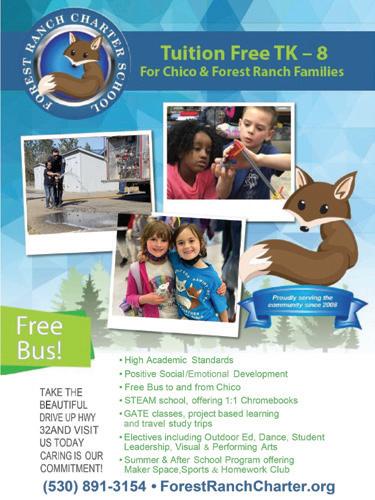
17. Help out at a community garden planting flowers, vegetables, weeding, watering or just helping with upkeep and maintenance.

18. Volunteer at a soup kitchen. Many people do this at Thanksgiving or during the holidays, but the need is there all year round.
19. Read books or newspapers to the visually impaired.
20. Help senior citizens with seasonal tasks like raking leaves in the fall, shoveling snow in the winter, or mowing the grass in the summer.
Connecting by Supporting
Whether you’re strolling around the Saturday Farmers Market or shopping at stores downtown, everywhere you look, there’s a local vendor who’s put their heart and soul into their products. Whether it be a delicious beverage from Live Life Juice, cookies from Upper Crust Bakery or T-shirts with your favorite swimming holes from Upper Park Clothing, shopping local is an amazing way to connect with the people in our community while stimulating our local economy.

By shopping locally, the sales tax generated from the local businesses go back into the community, providing funding for things helping to improve our city such as road maintenance and creation of public parks. In addition, shopping locally also allows for businesses to expand and hire more people, creating a better job market for

those in the area.
Not only is shopping local good for the community, it is also a great way to help protect our environment. Although shopping online may be convenient, the effects that it has on our environment are detrimental. According to NBC News, in 2017 Recology in San Francisco collected over 100 tons of cardboard waste every day, most of it coming directly from homes due to packaging from online shopping. Not only is the packaging harmful to our environment, the amount of emissions that come along with choosing options for fast delivery is concerning as well. Quick delivery options mean that trucks are delivering less items over further distances, creating longer distances per delivery. Companies even use planes in order to meet these fast deadlines. These emissions are some of the factors that play a role in warmer
temperatures and an increase of the rate of climate change.
Going to shop at local stores helps to mitigate some of the damage done by online shopping. Local shops such as Orange Street Consignment and Eighth and Main Antiques bring a second life to many items including furniture, clothing, and kitchen appliances. Buying from local stores such as these creates less waste, and you’ll be able to find an item that fits your unique taste. Even when it comes to clothing, shops such as Bootleg are great ways to find items that are still in great condition for a fraction of the price you would find at other big box retail stores. This is a win-win situation on all fronts.
Buying locally also helps with the hassle of proper sizing and customization of your wardrobe without the pesky return labels. Whether it’s finding the coziest fall hoodies from 3 Seas, the most comfortable shoe at Birkenstock, or the best outfit for the occasion from
WRITTEN BY BRIAN LUONG AND JASON CORONA
16 growing up chico magazine www.growingupchico.com winter fun
5th St. Clothing or For Elyse, there’s something for everyone. To complement the look, you can count on finding the right seasonal accessories from Anika Burke, some stylish shades at Winter & Co and the perfect handbag or purse at Tomfoolery.

We know that brands matter, and people have a strong connection to them. Your downtown shops have taken the time to invest in the names that you might think you have to travel for. Not only does Bird in Hand have the best selection of games and educational toys, but they also carry a wide selection of Tommy Bahama. Ever found yourself needing a C.C. Beanie and a Fossil watch in a pinch? Head over to The Watchman, and they have you covered. Need some KitchenAid or Le Creuset in your life? Collier's Hardware has the style and color you’re looking for. Most stores have that little something extra that you didn’t know you would needed but you’re glad you found along the way.
Home decorating is simplified within
a few short blocks. Find an elegant statement rug at Pasha or adorable serveware for your next event at Little Red Hen Home. When it comes to framing, Art Etc. and Chico Paper Company also take the time to go over the different frame sizes and options for your heirloom photos or favorite art pieces, what kinds of finishes they have available, and the right matting to make your piece pop.
By shopping local, you also learn a great deal about your surrounding area. For example, vendors at the Chico Saturday Farmers Market not only provide you with great produce, but talking with them allows you to learn about what’s in season, their growing techniques, and the best ways to enjoy their products. When shopping at your local farmers market, you can be sure that what you’re taking home was treated with respect from farmers who care about their craft.
One of the greatest benefits about shopping local is being able to support the people making up our community.


Many artists from Butte County have their art displayed at galleries, such as the Chico Art Center, which boasts a gift shop where proceeds from the art go back to the artists themselves. Cafés such as Upper Crust Bakery and Naked Lounge also display and sell artwork from local artists. There’s no shortage of performance art in Downtown Chico either. Theaters like the El Rey and Senator have a wide array of shows, California Regional Theatre now sits atop Collier's Hardware, and the world class shows at Laxson Auditorium have something for everyone.
Ultimately, by shopping locally, you’re able to see and learn about what exactly makes your community unique. When it comes to food, art, or music, seeing what your community has to offer is an amazing way to connect with the people and places within your area. More often than not, you’ll be surprised at all the hidden gems that are waiting around every corner.
Things to do on a Holiday Staycation
You can have a lot of fun during a holiday staycation. Here are five activities that are popular in my family. I’m sure your family will enjoy them, too.

Look At Photos

We all take them, on vacation and during the course of our daily lives, but how often do we kick back in the family room, with a cup of hot chocolate, and look, laugh and reminisce together. I’m talking, of course, of family photos. There really is nothing like looking back at photos of vacations from long ago, or hilarious experiences that you had as a family. If you’re really ambitious, put your favorite shots into those frames that you bought
ages ago and hang them up around the house together.
Play A Game
No matter how addicted they are to their electronic games, your kids can really get into hanging out together as a family if you play a good old-fashioned board game. A perennial favorite that’s going to leave everyone in stiches is Charades. If your kids are artistic, bring out whatever art supplies you have lying around and let them design their own board game. That’ll surely get the creative juices flowing! Of course, there are plenty of other options with a deck of cards, and our family loves Cranium!
Listen To Music
Most people walk around all day, in their private worlds, with music streaming through headphones. It’s fun to take out those ear phones and share the music with the rest of the family. One great way to do that is to gather around a computer and take turns selecting your favorite songs on YouTube. It’s incredible what musical journeys that can lead you on. And who knows: your kids’ – and your own – musical tastes may change in ways you didn’t realize was possible. If you have a karaoke machine, put in some new batteries and turn it on. If you don't, YouTube works just as well here, just add "lyrics" to the end of any song search.
WRITTEN BY TANNI HAAS, PH.D.
18 growing up chico magazine www.growingupchico.com winter fun
Cook A Meal
Few things bring a family together like cooking a meal. It’s active, fun, everyone can participate, and you get to enjoy the fruits of your labors in the end. To add excitement, make the meal prep a fun challenge. Agree that you can only cook with what you already have in the kitchen, which shouldn’t be too difficult, since it’s raining and no one feels like leaving the house. If your family is large enough, divide into two teams with responsibilities for different parts of the meal. One team makes the salad and dessert, the other team makes the main meal. Take turns in the kitchen, and don’t tell the other team what you’ve been cooking. Sitting down to eat will be a fun and surprising mystery.
Do Physical Exercises
Being indoors all day can make everyone feel a little bit stiff and in need of some movement. When that happens, get off the couch and onto the rug, and do some good old-fashioned stretching together. If someone knows yoga, this is a great time to teach the rest of the family some favorite poses.

Whatever you do, have fun doing it together, and your staycation will feel just as wonderful as any other vacation you've ever taken.

Santa ArriveS At Chico Marketplace Nov. 19TH Join us at 1PM as Santa arrives in an Antique Fire Engine and classic car parade! Special gift to the 1st 100 kids waiting for Santa. Performances by Kinetics Academy of Dance following the arrival. Make memories with photos in Santa’s magical workshop daily, Nov. 19th – Dec. 24th and don’t miss Pet Nights Tuesday Evenings in December! Find Santa Hours and more event details at ShopChicoMarketplace.com and Facebook.com/ChicoMall. Santa PhotoS & Visits • Nov. 19th–Dec. 24th
How To Choose The Best Volunteer Activities For Your Family
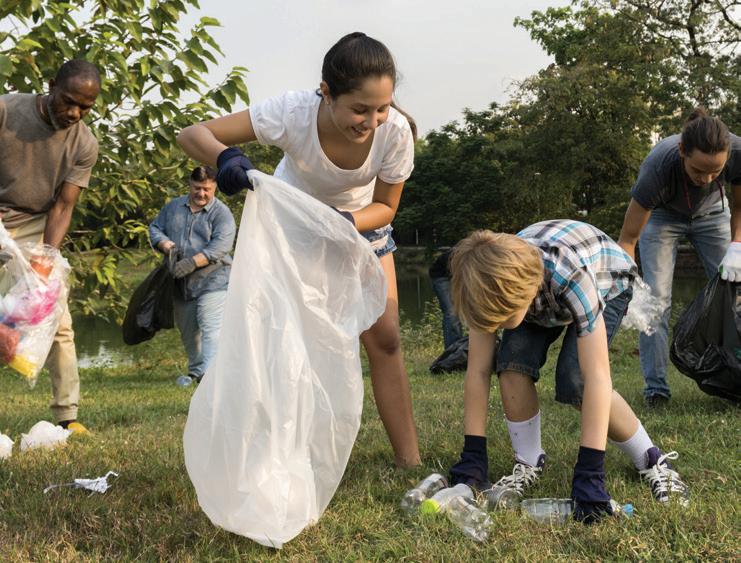
Volunteering as a family is such a wonderful way to bond and to feel better overall. When we make others happy, we experience an amazing biological phenomenon called a “helper’s high” that is the result of our brain releasing chemicals called endorphins. We experience an energy in our body that is similar to the rush we feel after we exercise. These positive feelings make our kids happier and healthier by reducing stress, anxiety, and feelings of sadness, loneliness, or depression.
Finding the right family volunteer activities can be overwhelming at times. You may feel uncertain about what is expected and question whether your children can participate. It is so important that your children feel comfortable where you volunteer, get inspired by the work you do, and enjoy themselves. Without these three components, our children
won’t reap all the amazing benefits of volunteering. Plus, we want them to love helping others so they continue to do so for a lifetime.
When searching for the appropriate activity, consider the following priorities:
Project Focus

The first step is to brainstorm as a family to decide what types of volunteer activities you are interested in doing.
Ask your children who they would like to help. Is there a particular cause they feel passionate about, such as feeding the homeless, making art for other children, helping animals, or visiting the elderly or sick? What interests, skills, and talents do your family members have? Do you prefer to be indoors or outdoors? Do you wish to work directly with people or do something quietly like painting or pulling weeds? The options are endless, so it is
important to narrow down your choices and focus on projects that your family will get the most out of.
Organization’s Mission
Do your research before you sign up with a specific organization. Find out the group’s history and how it got started, the goals and mission, who its leaders are, and how it is funded. Check their website, search online for press coverage, and visit sites like www.charitywatch.org and www.charitynavigator.org. If possible, ask a current or past volunteer about the pros and cons of the organization. Getting a referral from someone you know is the best option, especially because your children will be participating.
Location
Next, you will want to make sure you search for projects that are close to home so you do not have to drag your kids far to volunteer. Check your local paper, call charitable organizations, or search online to find the perfect places for kids to volunteer in your area.
WRITTEN BY SANDI SCHWARTZ
20 growing up chico magazine www.growingupchico.com parenting
Cost
Although rare, check to see if there are any fees to volunteer. You may also want to consider any other costs involved like travel, equipment such as certain clothing required, or requested products or monetary donations.


Time Commitment
Decide how much time you have to volunteer. It could be once a week, once a month, or once a year. Start slow and gradually increase your involvement if the project is working out well. You may choose to volunteer with different organizations each time to expose your children to a wide variety of experiences.
Age Range Guidelines
Look for activities that your whole family can participate in. Before you commit to a project, check to see if there are any age requirements listed. It may take some hunting around, but you should be able to find age-appropriate options. Even babies can take part in nursing home visits, charity walks, and beach clean ups.
Activity Expectations
Before you show up, find out exactly what you will be doing. Will there be heavy lifting involved? Will you have to get down and dirty? Will the project be a boring and repetitive task that will make your kids annoyed? Make sure the activity is something that your kids will actually enjoy before you invest your time.
Safety
No matter what, safety needs to come first when children are involved. You may want to avoid going to activities in neighborhoods that make you uncomfortable. Your kids may be scared to talk to strangers, so consider starting with familiar people and places. As they get older, you can start to venture out and expose them to more mature situations.


Fun Factor
Finally, if it isn’t an enjoyable experience for your kids, then what’s the point? Choose projects that involve your children in a fun way, but also teach and inspire them. Avoid topics and activities that are too serious and sad for young children. Be sure to engage with them afterwards and ask what they thought, and if they would be willing to do it again.
10 Science-Backed Benefits of Practicing Gratitude with Kids

Only recently have scientists begun to study the benefits of gratitude. Vitamin G, as some like to call it, plays a critical role in health and happiness. Focusing on the positive boosts body, mind, and spirit. It gives us energy, inspires us, and transforms us. In a nutshell, it provides life with meaning by thinking of life as a gift. Don’t you want to give this gift to your children?
Top 10 Benefits of Gratitude
Dr. Robert Emmons is the world’s leading scientific expert on gratitude. He conducted studies involving gratitude journals and found that when people regularly engage in gratitude, they experience the following measurable psychological, physical, and interpersonal benefits:
1. They feel better about their lives overall
2. They experience higher levels of positive emotions like optimism, enthusiasm, love, and happiness
3. They are kinder and more generous to others
4. They have fewer physical problems including pain
5. They exercise more regularly and eat healthier
6. They tend to sleep better
7. They visit the doctor more regularly for checkups
8. They often feel less stressed
9. They are able to cope with stress more effectively and recover more quickly from stressful situations

10. They live longer–on average, being thankful adds 7 years to our lives!
How It Works
Why does saying, "thank you" have so many benefits for us? When we count
our blessings, we interrupt the cycle of negative and fearful thoughts, which allows the stress system in our bodies to recover. Research shows that when we are thankful, we love our lives and want to make sure we stick around long enough to enjoy them. Also, when we receive praise from others, our brain releases the chemical dopamine, which encourages us to do more to receive such praise. This makes us want to thank others and make them feel good as well.
How To Teach Children Gratitude
In her book 10 Mindful Minutes, Goldie Hawn explains that being thankful is not a natural instinct; children need to be taught how to do it. She asks parents to be a good example to their children by thanking them often. It is important to explain to our children why they are being praised. Another important tip is to be careful not to judge how our children express gratitude. Young children under age seven may not fully grasp the concept. It is not what they are thankful for, but that they are learning how to express gratitude that matters. If they want to be thankful for a toy, that is okay.
Keeping a gratitude journal is the
WRITTEN BY SANDI SCHWARTZ
22 growing up chico magazine www.growingupchico.com parenting
backbone of gratitude scientific research. Anytime you read about gratitude, you will be asked to write down five points you are thankful for that day or week on an ongoing basis. Over time, you will begin to experience the benefits of gratitude such as stress reduction and optimism.



Some people don’t care for the traditional journal approach; they may find it repetitive and boring. Fortunately, there are many ways to express gratitude as a family, such as starting a nightly gratitude prayer ritual. Each family needs to discover what is most effective for them. Plus, you don’t want it to become an annoying chore–it is supposed to make you happier after all!
Here are some ideas for fun, creative gratitude journals using a variety of media. As technology changes, and our children learn more about what they can do with computers, iPads, and iPhones, we should show them how to use these tools for something positive–making them feel better.


5 Ways to Keep Gratitude Journals with Your Kids
Blog




Try setting up a family gratitude journal blog (password protected, of course). You can even involve grandparents and cousins, no matter how far away they live. You could introduce this idea at the Thanksgiving table and challenge everyone to submit a post each week throughout the year.
Audio Recording
Children love to hear their own voices. You can have them record their journal on a phone or iPad. Once you have the recordings, you can get really creative by posting them online for others to listen to or you can even put it to music and create a song using highlights of what they said.
Videos


Children also love watching videos of themselves. They will have a blast talking about what they are thankful for and watching it over and over. Maybe have them pretend to be reporters and their gratitude is the news of the day. Or they can act out scenes from the wonderful moments they had.
Drawings
For children who are more visual and artistic, ask them to draw or paint what they are thankful for at the time. You can then put the artwork together in a book organized by month or year. Create your own handmade journal or take pictures and use an online slideshow to present the images.
Collage
Looking for pictures in magazines or online to build a gratitude collage is a fun family project. And no artistic talent required! All that cutting is also a great way for your child to build fine motor skills.
Enjoy saying thank you with your children in these innovative ways. You can mix and match these media as well, such as posting videos on your gratitude blog.
#1 CHICO AREA HIGH SCHOOL 2022 OPEN ENROLLMENT FOR THE 2023-24 SCHOOL YEAR BEGINS DECEMBER 1! (530) 891-3090 • 335 WEST SACRAMENTO AVE. CHICO, CA INSPIRECHICO.ORG BiotechEngineeringRobotics Environmental Science Global Studies Audio & Video Production Theatre +more!CeramicsMusicDance Connected, Innovative Learning Award Winning Faculty & Staff College & Career Prep Curriculum Smaller Learning Environment Tuition-Free Public Charter High School ••••
Set the Stage for a Positive Dental Visit for Your Child
Most often, children's visits to the dentist are a positive experience for parents and kids alike. Despite this, between 9 and 15% of American adults fear dental visits, according to Cleveland Clinic. When parents are anxious about the dentist, that nervousness can instill fear and anxiety in their child, too.

Adults and kids may fear going to the dentist for several reasons. Cleveland Clinic explains that perhaps the adult or child had a negative dental experience or has heard horror stories that exaggerate their fears. The most common cause of anxiety is the fear of pain. Also, some kids and adults worry about the effectiveness or side effects of anesthesia or have a fear of needles.
A negative experience at the dentist as a child can result in continued anxiety over routine dental care even into adulthood. So, to ensure a positive, successful experience, know how to prepare yourself and your child for his or her first and subsequent dental visits. Doing so will pave the way to a lifelong devotion to regular and consistent dental care when your child becomes an adult.
Your child and the dentist – building a positive relationship early on The earlier your child begins visiting
the dentist, the better. The American Academy of Pediatric Dentistry recommends your child's first visit by the age of one or within six months of when the first tooth erupts. At this stage, your child's visit will be quick, simple, and painfree. Providing your child early positive experiences will help your child develop trust in the dentist.
Be aware that depending on your child's age and the dental office policies, many dentists will ask you to remain in the lobby during your child's checkup. This is the typical recommendation for children over the age of three. There's a good reason for this. Separating a child from parents usually results in fuller cooperation from children. This can go a long way toward a more positive experience for your child.
When your child is placed in the care of the dental staff, they'll try to make your child's first experience fun and informative. The dentist will explain and demonstrate routine procedures to your child and then perform those procedures. Your child quickly learns the dentist is someone to trust.
Down the road, if your child needs non-routine dental work, the dentist will similarly work with your child to help
explain and alleviate fears.
If you're still concerned with sending your child in alone, call and ask to speak with the dentist or hygienist. Avoid causing your child alarm, and make the call in private so your child doesn't pick up on your anxiety. Explain your specific concerns so the dentist can address and alleviate your worries.
Approaching scared or uncooperative children

For a variety of reasons, some children become fearful or uncooperative during a visit to the dentist. If your child arrives unprepared or senses your anxiety, your child may develop undue worry. Previous experience could also cause stress. Kids who are ill or have a physical or mental disability, a behavioral disorder, or developmental delay may also be challenging to treat. Whatever the reason, the way your dentist handles your child's fears and behavior is vital to your child's emotional well being and ability to cope with future visits.
The American Academy of Pediatric Dentistry has developed guidelines for behavior management that dentists should follow. Your dentist should use the communication techniques learned in dental school, including positive reinforcement, distraction, voice control, non-verbal communication, and the tellshow-do approach.
These techniques all help reassure
WRITTEN BY KIMBERLY BLAKER
24 growing up chico magazine www.growingupchico.com parenting
patients and gain their trust. In most cases, these approaches are sufficient, leading to visits that end on a positive note. If a practitioner lacks the expertise for handling a situation, he should refer your child to a dentist with the appropriate skills.
Prevent an experience that heightens your child’s fears by being proactive
- Contact your state's board of dentistry when choosing a practitioner to make sure there have been no disciplinary actions.
- Inform your dentist of any medical, behavior, or other conditions that might affect your child's visit. That way, the dentist can communicate with your child accordingly.
- Pediatric dentists have specialized training for dealing with situations that can arise with children. If you suspect your child may have difficulty with dental visits, seek a pediatric dentist.

Tips to get your child off on the right track
Tell your child about the benefits of going to the dentist, such as to help keep their teeth strong and healthy, and so they'll have a beautiful smile.
Read to your child before their first visit to the dentist. Try one of the following:
- Why We Go to the Dentist by Rosalyn Clark
- The Berenstain Bears Visit the Dentist by Stan Berenstain and Jan Berenstain
- Celebrate! Going to the Dentist by Sophia Day
- Dentist Trip (Peppa Pig) by Scholastic
- Curious George Visits the Dentist by H.A. Rey
Share a DVD with your child, such as A Trip to the Dentist Through Pinatta’s View.
Also, express positive feelings about your own dental experiences. Don't discuss non-routine procedures such as fillings. Explain to your child the necessary procedures he can expect. For example, the dentist will count your child's teeth and look at them with a tiny mirror. Avoid frightening terminology.
As your child grows, if you have concern over a possible cavity, don't give your child too much information. This can result in undue anxiety. Your dentist should have the experience and expertise to talk to your child about such procedures in a manner that alleviates any stress your child might experience.

If your child is anxious, don't try to soothe your child by lying about a procedure or possible pain. Instead, try to alleviate fears that may be out of proportion to the situation.
Finally, offer coping strategies to your child. Have him practice taking long deep breaths. If you've confirmed with your child's dentist that you'll be attending your child throughout the procedure, you can offer your hand to squeeze.
birthdays
10 Tips on Making Your Child's December Birthday Party Specia l

When my daughter was born on a cold December night, I was overwhelmed with love. I cuddled with her as my husband and I listened to Christmas music. We found an ornament in the hospital gift shop with her name on it. We dined on a Christmas dinner that year that someone else prepared.
Having a baby in December? It was better than I expected.
Fast forward 10 years and nearly as many birthday parties later. December birthdays can be sweet, but they can be hard when it comes to throwing birthday parties. Luckily, I have years of experience and 10 tips to share that will make your child's next December birthday party as fun and stress-free as possible.
1. Plan in advance. Everyone is busy during the holidays. There are gifts to buy, parties to attend, and special activities at school. I recommend picking a date for your party as far in advance as possible.
2. Be flexible with your date. Every year, our town hosts a holiday parade on the Saturday closest to my daughter's birthday. The whole town goes. Thus, to avoid competing with it we usually have her party a week or so after her birthday.
3. Consider piggybacking on a special holiday event. Once we took my daughter and her friends to a "Visit with Santa" event. The kids visited businesses in a shopping center collecting candy or toys before meeting Santa. The treats served as their goody bags (bonus!) and afterwards, we celebrated with cake at our house. That party was one of the easiest we've had.
4. Think right before or after the holidays. If you can wait until the weekend before Christmas, then kids are ready to attend a birthday party. By then, they've already visited Santa, had their school party, performed in the holiday play, etc. The same goes with right after New Year. All the holiday excitement is gone and kids are bored—and available.
5. Skip the week between Christmas and New Years. Not only is it Kwanzaa, but most people are traveling or entertaining relatives.
6. Prepare your child that not everyone can come. One year, a friend couldn't come because she was celebrating the holidays early with out-of-town family. It's no different from other times of the year. My oldest child has a summer birthday, and someone is always on vacation.
7. Go full-out birthday party mode. Yes, Christmas music blares from every stereo, and the stores offer gifts galore for Hanukkah’s eight nights. That makes it even more important to celebrate with a standard birthday cake and typical birthday party decorations.
8. Prepare your child that someone may double-up on a birthday/holiday gift. Most kids don't do this. Usually, the two-for-one gift is from a relative. It's not the end of the world.
9. Give yourself a pep-talk. I'm not going to lie—planning and throwing a birthday party amidst all the other things you have to do during the holidays is hard, but we are parents. We are nothing if not strong!
10. Remember it is your child's special day, no matter where it falls on the calendar. I like to remind people of this fact whenever someone says, "It must be so hard having a birthday in December." Because it doesn't have to be hard, it can be awesome.
Throwing a birthday party during the holidays? It can be done. And, if you keep these tips in mind, it can be a happy birthday indeed.
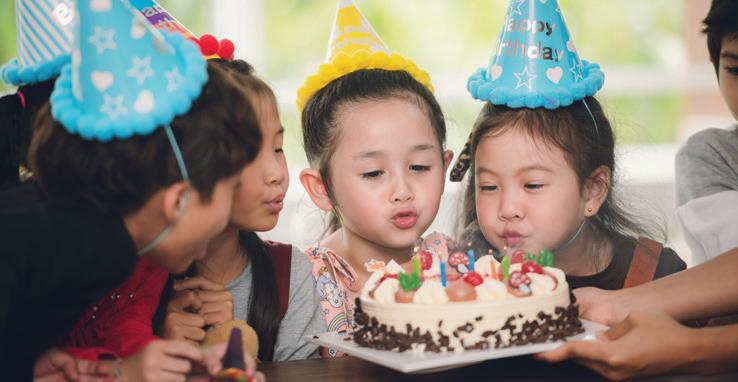 WRITTEN BY KATY CLARK
WRITTEN BY KATY CLARK
26 growing up chico magazine www.growingupchico.com winter



'Tis the Season to Go Plastic-Free
With so much to do during the holiday season, all of that pesky plastic can easily slip right by us. From gift wrap and packaging to decorations to party supplies, we can easily get lost in piles of unnecessary plastic. However, when we shift our mindset a bit, we can find more eco-friendly options to use during our holiday celebrations. Here are some tips to ensure that you stay as plastic-free as possible throughout the holidays.
Party Goods
Whether you are in charge of throwing the big office holiday party or an intimate family holiday dinner, you can control whether plastic shows up as one of your guests. First of all, avoid using plasticware and serveware. Instead, choose paper (recycled is best), bamboo, or even plates and utensils made out of palm leaves. Next, be sure to use real wine glasses— not plastic ones—and don’t serve your drinks with plastic straws or stirrers. If possible, use real cloth tablecloths
instead of those cheap plastic throwaway ones. Be mindful of which food items you purchase at the grocery store to avoid those wrapped in all of that excessive plastic, such as dips and pre-packaged fruit salads. Finally, when you store your food or package it up to transport it to a party, be sure to avoid plastic containers and plastic wrap.
Decorations
What kind of holiday celebration could we possible have without all the festive decorations? Unfortunately, many of the traditional decorations are massproduced using plastic. Here are some ways to still show your holiday spirit minus the plastic.
Make your own. Part of the issue with holiday decorations is that they come packaged with tons of plastic. To avoid that altogether, make some of your own decorations out of non-plastic materials. For example, use last year’s holiday

wrapping paper, bows, and ribbons to decorate a wreath or to create a festive wall hanging. Or sew your own stockings for the fireplace using material from old clothes. The options are endless!

Go natural. Instead of running to the stores stocked with plastic decorations, consider decorating your home more naturally by using items like plants, sprigs of holly and fir, twigs and branches, mistletoe, pine cones, popcorn garland, dried citrus rings, cinnamon sticks, wooden ornaments made from cut logs, cranberry garlands, and dried flowers and leaves. Go for a lovely hike outdoors a few weeks before the holiday to collect your special nature décor. Plus, all of these items can be composted after the holiday season.
Shop second hand. One way to cut back on the plastic being used in the market is to reduce demand by shopping second hand. Check out local thrift stores, online sites like freecycle.org, and garage sales
WRITTEN BY SANDI SCHWARTZ
28 growing up chico magazine www.growingupchico.com winter fun
for some treasures that can add a sparkle to your holiday look. When you choose to reuse, you are reducing plastic waste and keeping items from ending up in the landfill.
Trade with friends and family. Another way cut back on new plastic decorations is to organize a decoration swap with friends and family. Many of us get bored of the same old decorations year after year, so by trading with others, we can all get a fresh new look for the holiday season. This would be really fun to do with your neighbors along with a block party or progressive dinner party as everyone moves from house to house.
The Tree
Real or plastic tree? This has been a hotly debated topic over the years. After weighing all the pros and cons, experts conclude that real Christmas trees are still the better option for the environment.
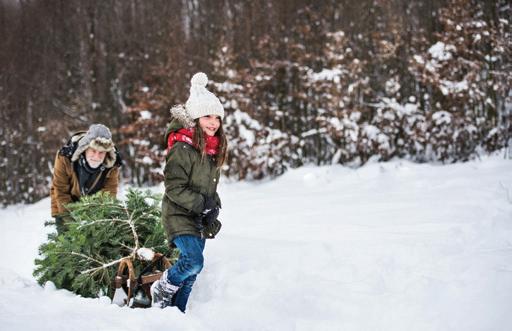
According to the New York Times, the most comprehensive study by an environmental consulting firm to determine whether real trees or fake tress are more eco-friendly found that an artificial tree would have to be reused for more than 20 years to be greener than buying a fresh-cut tree annually. These calculations take into account greenhouse gas emissions, use of resources, and human health impacts.
Real trees are also biodegradable, which means they can be easily reused or recycled for mulch and other purposes. On the other hand, most artificial Christmas trees are made of metals and plastics that are not recyclable and ultimately end up in a landfill. Most also contain the
petroleum-based polyvinyl chloride, or PVC, which produces carcinogens during manufacturing and disposal. Finally, the living trees grown in farms produce oxygen, reduce carbon dioxide, and provide habitat for wildlife.
Gift Wrap
Whether we are talking about wrapping paper (that is sold in plastic) or cellophane, gift wrap can be a real waste. Fortunately, there are plenty of other ways to present your gifts to your loved ones.
- Save gift bags from other events and last year’s holiday season and reuse them year after year.
- Make the wrapping part of the gift by using items like handkerchiefs, scarves, blankets, or place mats.
- Use fun cloth bags of all sizes and patterns to enclose your gift.
- Make your own wrapping paper by using the plain backside of used paper and decorating it with holiday-themed stamps or other design elements.
- For smaller gifts, you can use jars or reusable containers.
- Go rustic by using recycled brown parcel or butcher paper tied in twine or cloth ribbon.
- If you have something fragile, opt for shredded paper instead of polystyrene packing material.
Gift Giving
Last but not least, the types of gifts we choose to give can have a huge impact on our plastic use. So many gifts are either made out of plastic materials or wrapped in layers of plastic. Consider choosing more meaningful gifts to give to friends and loved ones that also happen to be plasticfree:
- Make your own crafts from recycled and reused materials.
- Bake yummy organic treats and deliver them in a basket, cloth bag, or ceramic jar.

- Share flowers and produce from your garden and present them as an attractive care package.
- Seek out natural and organic products such as organic cotton clothing, essential oils, and natural beauty products sold in non-plastic containers.
- Opt for an experience like hiking, taking an art class, attending a music or theater performance, visiting a museum, or going to a sports event.
Make this holiday season as plastic-free as it can be!
Parenting Resources
Butte Baby Steps
The Butte Baby Steps program is a national program model designed to help expectant and new parents get their children off to a healthy start. The program serves Butte County families. Butte Baby Steps is open to parents of all ages that are either expecting or have a child under the age of 3 months. 345-1600, nvcss.org/programs/butte-baby-steps/.
Butte County First 5 first5butte.org, 530-538-7964.
Butte College Foster/Kinship Education
For more info and a current workshop schedule, call 530-897-6235.
Butte County Library 891-2762, www.buttecounty.net/bclibrary.
Chico Area Park & Recreation District
Recreational activities and programs yearround include programs for children, adults, and seniors. Sports, camps, after-school program, preschool program, and leisure activities are offered. 530-895-4711, 545 Vallombrosa Ave., www.chicorec.com.
Chico Mothers Club
Find them on Facebook or go to www.chicomothersclub.org for more info.
Durham Recreation & Park District DRPD offers many sports, classes/lessons, and programs for all ages. 530-345-1921, durhamrecreation.recdesk.com.
Enloe Mother & Baby Outreach Program 530-332-5520, or online at www.enloe.org/baby.
HelpCentral.org

You can find services such as emergency food, parenting classes, recreational programs, support groups, drug treatment, tax assistance, in-home help, after school programs, hospice, counseling, and subsidized daycare at www.helpcentral.org.
Help Me Grow
Help Me Grow Butte is a free service available to all families in Butte County with children aged 0-5 who are interested in learning more about their child’s development or behavior. Help Me Grow Butte works directly with caregivers to ensure they are connected to the services and resources they need to help their children thrive. To learn more about your child’s development visit our website at www. helpmegrowbutte.org or call 530-552-3919 to connect with a Care Coordinator.
Mothers Strong
Mothers Strong is a group of mothers, professionals, and other advocates dedicated to bringing vital mental health information to
moms and families in Butte County. Mothers Strong helps connect local Butte County families with support, education and resources to help with postpartum anxiety, depression and other mood disorders. To find resources for Perinatal Mood and Anxiety Disorders visit www.mothers-strong.org and follow us on www.facebook.com/MothersStrong.
Northern Valley Catholic Social Service, Inc.
Provides low-cost or free mental health, housing, vocational, and support services to individuals and families in California’s Northern Sacramento Valley. 800-846-1451, www.nvcss. org.
Paradise Recreation & Park District PRPD offers a wide range of recreation programming, including after school programming, summer camp, preschool activities, youth and adult sports, senior services, aquatics, teen programs, and numerous special events. 530-872-6393, www. paradiseprpd.com.
Valley Oak Children’s Services
Valley Oak is a Resource and Referral Program that provides free referrals for child care and other family-related services. Low-Income parents can call and get on the Centralized Eligibility List for preschool and subsidized child care in Butte County. Call 530-895-3572 or 1-800-345-8627 or visit valleyoakchildren.org for more information.
WIC
This program provides supplemental food vouchers and nutrition education to pregnant and breastfeeding women, infants and children up through age five who qualify in Butte County. The WIC staff provides parent education about nutrition, breastfeeding, child safety, growth/development, and other child-appropriate topics. 530-891-2767, www. buttecounty.net/publichealth/Programs/WIC.
Youth for Change Family Resource Centers youth4change.org. 530-877-1965.
Special Needs
ARC Family Support Program
Families who experience the challenges that come along with raising a child with a special need are invited to this support group hosted by ARC of Butte County. 530-891-8157.
Autism LifeSpan
Supports individuals with developmental disabilities & their families.autismlifespan.org. 2418 Cohasset Rd., Ste. 150. 530-897-0900.
Far Northern Regional Center
A fixed point of referral for individuals with developmental disabilities and their families.
FNRC also provides services to infants and toddlers (from birth to three years old) who are showing a delay in their development or who are at substantially high risk for a developmental disability. FNRC coordinates community resources such as education, recreation, health, rehabilitation, and welfare for individuals with developmental disabilities. 530-895-8633.
Little Red Hen LifeSpan Center
This nonprofit organization offers year-round socialization training programs for children, teens, and young adults with an autism spectrum disorder. Provides sensory exploration & behavioral support in a fun & engaging environment. www.littleredhen.org/lifespancenter.html. 530-897-0300.
Work Training Center
WTC is dedicated to meeting the training, vocational, and recreational needs of people ages 18 & up with disabilities. 2255 Fair St. www.wtcinc.org. 530-343-7994.
Parent Infant Programs
A developmental program designed for children diagnosed at birth with a regional center qualifying condition or children at risk of developing those qualifying conditions. 530343-8106, www.parentinfantprograms.com.
Rowell Family Empowerment of Northern California
They provide support, education, and advocacy services to families with children ages birth to 26 with special education needs living in Northern California. For information on trainings and support groups, please call the Chico office at 530-899-8801 and toll-free 888-263-1311 or www.rfenc.org. Hablamos Español.
The Enloe Health Learning Center
The Learning Center is a community library. We invite you to browse a broad array of health and medical information. Learn more about a disease or disorder affecting a family member, research a medical diagnosis, or find wellness information. A free library card gives you access to health care information through books and periodicals, www.enloe.org/library.
Wings of Eagles
Emotional and financial assistance to all families in the four-county areas of Butte, Glenn, Tehama, and Colusa who have children with a pediatric cancer or a life-threatening illness diagnosis. 530-893-9231.
For More Resources, Visit www.GrowingUpChico.com.
Do
you know of a resource you wouldlike to see listed, or does a listing needto be updated? Let us know! Email usat: jason@growingupchico.com.
Have a resource for us?
This is your guide to free, or low-cost family resources in Butte County!








2022–2023 Season Tickets Now On Sale www.chicoperformances.com NOVEMBER LYLE LOVETT and JOHN HIATT LAS CAFETERAS: HASTALAMUERTE A Day of the Dead Celebration DECEMBER TOMMY EMMANUEL, CGP, with Mike Dawes THE MAVERICKS with special guest JD McPherson: Very Merry Christmas Tour NOCHEBUENA: A Christmas Spectacular JANUARY JAZZ AT LINCOLN CENTER: Songs We Love FEBRUARY CHICO COMMUNITY BALLET: Sleeping Beauty PILOBOLUS BIG FIVE-OH! NEIL BERG’S 50 Years of Rock & Roll TREELOGY: A Musical Portrait of California’s Redwood, Sequoia and Joshua Trees MARCH TAKE ME TO THE RIVER: NOLA LIVE! Dumpstaphunk, George Porter Jr. & Jon Cleary PINK MARTINI featuring China Forbes LOS LOBOS with special guest Gaby Moreno BANFF MOUNTAIN FILM FESTIVAL APRIL THI BUI: THE BEST WE COULD DO THE BALOURDET QUARTET 2 9 11 13 19 24 3–5 17 24 28 2 9 19 24–25 5 23 THI BUI Pink Martini The Balourdet Quartet Las Cafeteras The Mavericks Pilobolus: Big Five-Oh! UPCOMING PERFORMANCES Vivaldi and Pizazzola, Chee-Yun, violin | November 12, 13 Holiday Pops | December 9–11 Haydn’s Drumroll | February 11,12 Young People’s Concert | March 7–9 Rachmaninoff, Charlie Albright, piano | May 13, 14 Joy experience THERE’S A SEAT WAITING FOR YOU! It’s easy to reserve your tickets at northstatesymphony.org Contact the University Box Office in Chico at 530-898-6333 or www.chicostatetickets.com The Cascade Theater Box Office in Redding at 530-243-8877 or www.cascadetheater.org More information: northstatesymphony.org

























































































































 WRITTEN BY KATY CLARK
WRITTEN BY KATY CLARK














